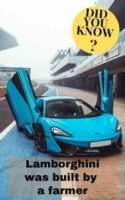“You may be able to drive a tractor but you will never be able to handle a Ferrari properly,” said Enzo Ferrari, the manufacturer of Ferrari automobiles, to Ferruccio Lamborghini when he criticised his cars.
Who was Ferruccio Lamborghini?
On 28 April 1916, Antonio and Evelina Lamborghini gave birth to Ferruccio Lamborghini in a rural farm in Northern Italy. Unlike most farmers in his home town, Lamborghini was more interested in farming machinery and engineering.
Lamborghini enrolled at the Fratelli Taddia technical institute to pursue his passion in mechanics. Antonio was reportedly not happy with his son’s decision because he wanted him to continue farming the fields like most people in their town.
Lamborghini was drafted into the Italian Royal Air Force during World War II. He served as a mechanic during his military service and worked his way up to becoming the supervisor of the unit responsible for vehicle maintenance.
In 1945, towards the end of the war, Lamborghini was taken war prisoner by the British and couldn’t go back home until the following year.
Italy was in serious financial crisis after the war. Infrastructures had been destroyed including agricultural equipment that many families depended on for their survival. The country was pressured to produce cost effective solutions to the problems that it faced.
Lamborghini went back home and opened a garage in Pieve di Cento, a town that is less than 8 km from his hometown. He put his mechanical abilities into use by fixing vehicles that were damaged during the war.
In 1948, Lamborghini founded Lamborghini Trattori. His company manufactured its first tractors using materials and parts from abandoned war vehicles. Lamborghini Trattori grew so quickly that in just few years it was financially able to stop producing its tractors using discarded war material.
1951 marked the production of the first tractor that used only parts that were manufactured by Lamborghini Trattori. The only part that wasn’t made in-house was its engine. Lamborghini’s business blossomed and he became one of the wealthiest industrialists of his time.
As money grew in his bank account, so did his love for fast cars. Lamborghini owned numerous cars including Alfa Romeos, Maserati 3500GTS, Mercedes-Benz 300SL and a Jaguar E-Type.
In 1958, Lamborghini bought a new Ferrari 250GT. He loved the car so much that he went to buy more Ferraris over the years. However, Lamborghini felt the cars needed to be upgraded because they made too much noise and were not smooth on the road.
Lamborghini also noticed that the Ferraris had poor clutches and they frequently burned out. For repairs he was forced to travel to Maranello, a town where he bought his Ferraris. To his dismay, Lamborghini discovered that Ferrari fitted the same clutch that he fitted on his small tractors.
Lamborghini requested a meeting with Ferrari to convey his dissatisfaction with his cars. The meeting never went as Lamborghini expected. The prideful Ferrari dismissed the Lamborghini Trattori founder and told him to focus on what he knew best – manufacturing farming equipment.
Ferrari reportedly told Lamborghini, “You are a tractor driver, you are a farmer. You shouldn’t complain driving my cars because they are the best cars in the world.”
“Yes, I am a farmer, but I’ll show you how a sports car should be,” Lamborghini responded.
The meeting between these business moguls signalled the beginning of their rivalry. Lamborghini founded Automobili Lamborghini and recruited the best team to compete with his newly acquired business rival.
Many people criticised Lamborghini’s decision to compete with Ferrari who was already successful in the exotic car manufacturing business. They didn’t believe he would make a worthy rivalry for Ferrari.
Lamborghini silenced his critics when he sold his first 13 cars in 1964. Lamborghini’s cars were praised for their comfort, power and luxury. According to lamborghinicars.com, Automobili Lamborghini has produced over 500 cars per year since 1963.
Ferruccio Lamborghini refused to let his background determine his future. Had he chosen to spend his life driving tractors instead of learning how to manufacture them, he would have struggled like most farmers after World War II.
***
Did you know what the five stages of grief are? Read here to find out.
Tell us: What inspiration can you draw from this article?

